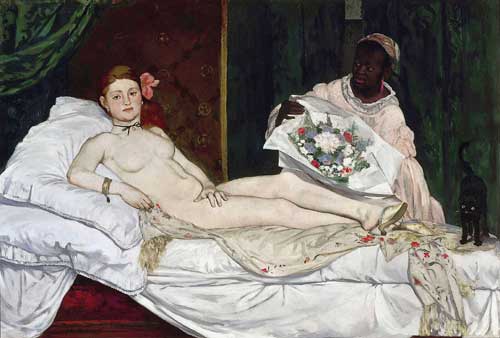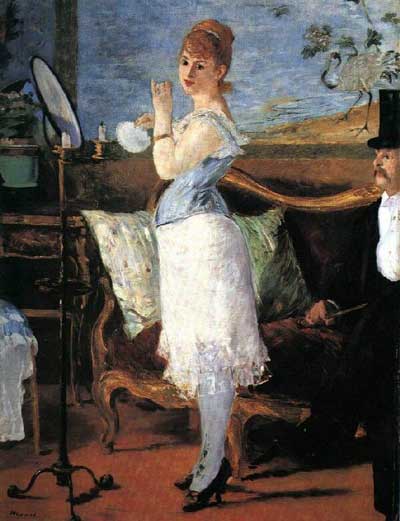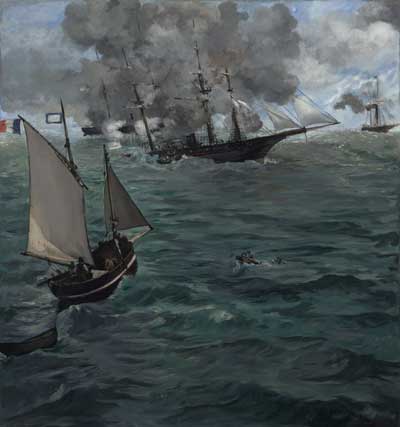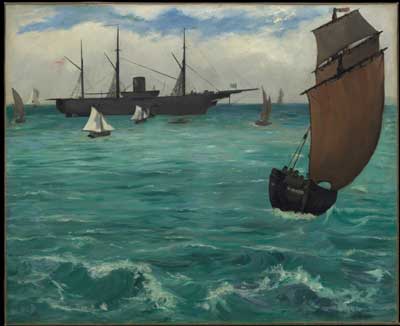|

This file was derived from: Edouard Manet - Olympia - Google Art Project.jpg:,
Public Domain, https://commons.wikimedia.org/w/index.php?curid=79557212
In my many years of haunting art museums—the National Gallery of Art in
Washington, DC, the Musée d'Orsay in Paris, et al.—my admiration of
Édouard Manet, high from my very first viewing, has increased steadily.
Two recent events have elevated this regard to full-blown, limitless love.
The first, occurring late in 2022, was my reading, as a volunteer first reader
for the Arts Club of Washington's Marfield Prize, of Value in Art: Manet
and the Slave Trade, (1) by Henry M. Sayre. Sayre's masterful study, richly
illustrated, presents Manet's work in the cultural and political context of
his time, France's Second Empire, and place, primarily Paris, its capital.
Underneath the magnificent surfaces, exquisite images, and beautiful
colors (his blacks and blues in particular capture the eye and shimmer into
one's consciousness), Manet subtly but strongly criticized the political and
sexual hypocrisies of his era. Like his comrades-in-arms Émile Zola and
Charles Baudelaire, but with a lighter touch, Manet again and again
directed pointed criticism at the sexual and economic politics that limited
women to marriage, prostitution, or destitution, the evils of colonialism
and slavery, and bourgeois values in general. Like the Impressionists, and
more powerfully, he was indeed the painter of modern life (as designated
by the preeminent Manet scholar, T.J. Clark, the title of whose critical work
I have borrowed for this essay).
The second and even more powerful event was my recent visit to the
Metropolitan Museum of Art in New York City to see the incredible exhibit Manet/Degas. Though I greatly admire Degas and enjoyed seeing his
paintings and other works displayed alongside those of his "frenemy"
Manet, my motivation for the excursion was to see Manet's paintings,
especially his perhaps most shocking and controversial (in his day), Olympia (depicted above). This exhibit is the first time the picture has
been shown in the United States. (I may have seen it on one of my trips to
Paris in the 1980s, but my love for Manet was but a spark then, not to
mention how much great art I feasted on). In the intervening years and in
light of my encounter with Sayre's book, I have become supremely
captivated with this masterpiece to the point I have written a poem
about it. (More on that below.)
From a purely artistic standpoint, the picture is a remarkable display of
colors, demonstrating Manet's extreme skill with shades of black along with
the near shimmer of the colors of the flowers that Olympia's servant is
presenting.
Beyond the aesthetic, the painting encodes a world of commentary about
social and sexual attitudes in Paris in the latter half of the 19th Century.
The polished surface and beautifully balanced composition open a window
on complex relationships between and among the figures in the painting,
those just outside, and the viewers themselves. Olympia is, of course, the
name of the central character (the model being Victorine Meurent)
portrayed in the picture. Her frank and unashamed gaze at the viewer
shocked the Parisian audience as many of the details in the painting
indicate that she is a prostitute (the name "Olympia" itself was a term used
for prostitutes). In addition, such elements as the lavish bedding, her
jewels, and even the black cat (a symbol of nocturnal promiscuity) all
suggest a life of unabashed sensuality.
The role of the Black servant (a model known only as Laure), is more
ambiguous. The complexities of her racial and feminine position are
beyond the scope of this essay, but there are a number of valuable writings
on those elements by feminist and Black critics that are worth seeking out
to pursue that line of analysis.
A similar and nearly equally ravishing treatment of feminine defiance of
sexual shaming is found in Nana, an image of a character in two novels by
Manet's friend Zola.

Courtesy of manet.org.
This painting was the cover image for my Penguin Classics edition of Zola's
Nana, and the pleasurable shock of recognition I received when I rounded
the corner into its gallery was one of the many amazing experiences I had
in the show
However radical some of Manet's thought was, no doubt his racial attitudes
were not free from the prejudices of his time. Nevertheless, he was a
known anti-colonialist and opponent of slavery, which France had
outlawed long prior to the creation of Olympia. Two other paintings in the
Met exhibit reflect his abolitionist sympathies. The Battle of the Kearsarge
and the Alabama, depicts a crucial naval battle between the U.S. Navy ship, Kearsarge and the Confederate vessel C.S.S. Alabama in June 1864 off the
coast of Cherbourg, which resulted in the sinking of the Southern ship,
much to the delight of the pro-Northern spectators who had gathered on
the shore to witness the engagement. Manet himself was not present, but
he read accounts of the battle and, wishing to celebrate the outcome,
quickly painted the picture and placed it in a gallery.

Philadelphia Museum of Art
He later traveled to Boulogne to see the Kearsarge in port there, and made
a lovely painting of the ship at rest in the harbor.

Metropolitan Museum of Art
These two marine images along with Nana above display Manet's great
skill with blues as well as blacks.
The entire show was an almost overwhelming experience. For lovers of
19th Century painting and Impressionism, it's a feast verging on oversatiety
. For reasons I noted above, I have not written about Degas, but the many
works of his on display are, obviously, splendid, and I was enriched greatly
by seeing them. But for me, Manet was the draw. The emotional impact of
encountering many favorite paintings I had only seen in reproduction
before is indescribable. And the communion with kindred spirits, old and
young alike, was a near spiritual experience in itself. I staggered out of the
exhibit after two hours and made my way to the cafeteria to fill my stomach
as I had my soul.
The show runs until January 7, 2024. It's well worth seeing in person if
possible If not, a virtual tour and other information at the museum's
website are available.
https://www.metmuseum.org/exhibitions/manet-degas
Note:
(1) https://press.uchicago.edu/ucp/books/book/chicago/V/bo115834914
.html
|